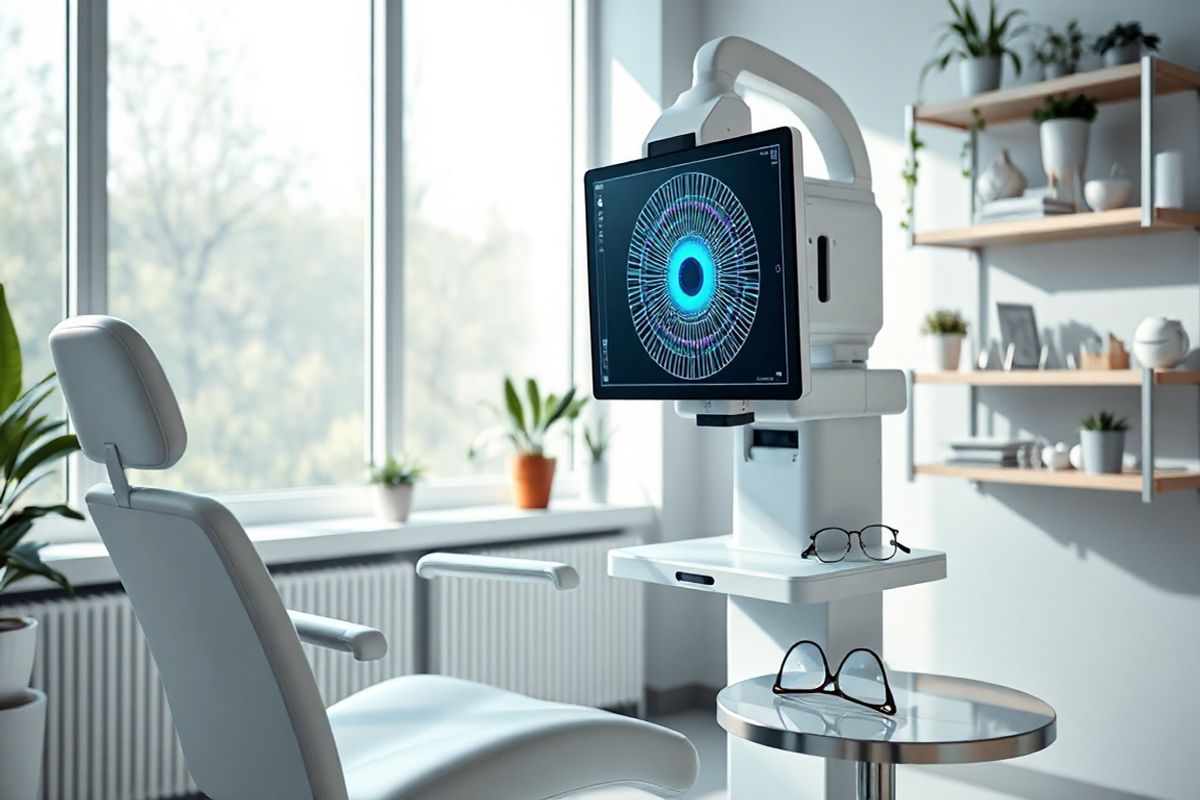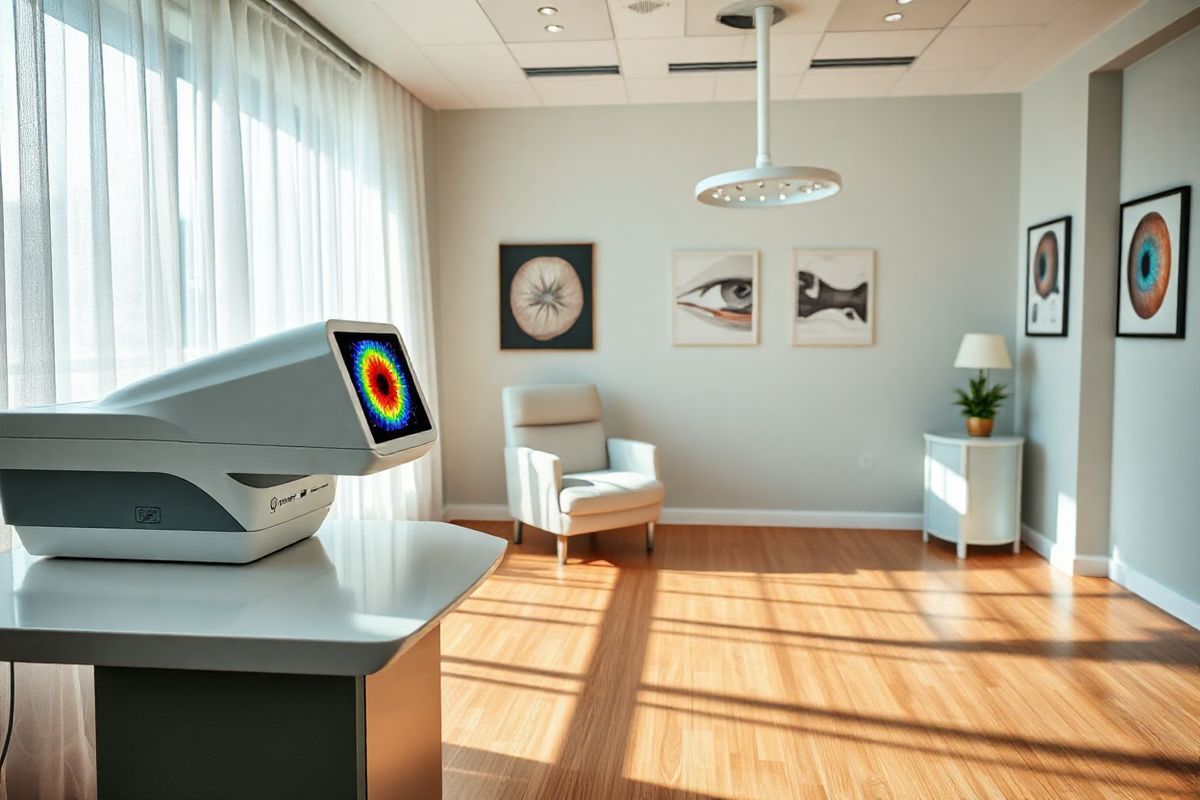Table of Contents
Understanding Conductive Keratoplasty: A Brief Overview

Conductive keratoplasty (CK) is an innovative vision correction technique primarily aimed at treating mild to moderate hyperopia (farsightedness) and presbyopia, a condition often associated with aging that affects the ability to see objects up close. This procedure represents a significant advancement in the realm of refractive surgery, offering a less invasive alternative to traditional laser surgeries like LASIK. CK utilizes radiofrequency energy rather than laser technology to reshape the cornea, which can be particularly beneficial for patients who may not be ideal candidates for laser procedures due to various ocular conditions or corneal thickness limitations (Healthline, 2023).
For individuals who find themselves increasingly reliant on reading glasses or who struggle with the visual demands of modern life, CK presents a promising option. It is especially appealing for those over the age of 40 who are experiencing the early signs of presbyopia but do not wish to undergo more invasive surgical interventions (Medscape, 2023).
How Conductive Keratoplasty Works: The Science Behind the Procedure

The underlying mechanism of CK is based on the principle of collagen shrinkage. When the radiofrequency energy is applied to the peripheral cornea, it causes the collagen fibers to contract, effectively steepening the central cornea. This reshaping allows for improved light focus on the retina, thereby enhancing visual clarity.
The procedure begins with an eye examination conducted by a qualified ophthalmologist, where the patient’s overall eye health and suitability for CK are assessed. If deemed appropriate, the following steps are typically involved:
- Preparation: The patient is seated comfortably, and numbing eye drops are administered to ensure a pain-free experience.
- Mapping the Cornea: A corneal topographer is used to create a detailed map of the patient’s cornea. This mapping is crucial for determining the precise locations for the application of radiofrequency energy.
- Application of Radiofrequency Energy: A handheld probe is used to deliver controlled radio waves to specific points on the cornea, following the predetermined pattern established during mapping. This step typically lasts only a few minutes and is generally painless, although some patients may feel mild pressure.
- Post-Procedure Care: Following the application, antibiotic eye drops are often administered, and a soft contact lens may be placed on the eye to minimize discomfort and aid in healing.
Patients can expect a relatively quick recovery, with many returning to their normal activities within a day or two. However, a follow-up appointment is essential to monitor the healing process and adjust any post-operative care as necessary (Healthline, 2023; Mayo Clinic, 2023).
Ideal Candidates for Conductive Keratoplasty: Who Can Benefit?
CK is particularly suitable for individuals who meet specific criteria:
- Age and Stability: Candidates are typically at least 40 years old and should have a stable vision prescription for the past year.
- Refractive Error: CK is effective for those with mild to moderate hyperopia (between +0.75 D and +3.25 D) and presbyopia.
- Eye Health: Candidates should be free from any eye diseases or conditions that could complicate the procedure, such as keratoconus or severe dry eye syndrome.
- Expectations: It is important for candidates to have realistic expectations regarding the outcomes of the procedure, understanding that some may still require reading glasses post-surgery.
Conversely, those with significant corneal thinning, advanced cataracts, or other serious eye conditions may not be suitable candidates for CK (Mayo Clinic, 2023).
The Procedure Experience: What to Expect Before, During, and After
Before the Procedure: Patients will undergo a comprehensive eye exam, including measurements of corneal thickness and curvature. They will be advised to cease wearing contact lenses for a period leading up to the exam, as contacts can alter the shape of the cornea and affect measurement accuracy.
During the Procedure: The CK procedure itself is quick, usually taking less than 30 minutes. Patients remain awake and alert throughout, with only numbing drops used for anesthesia. The application of radiofrequency energy is typically painless, although a sensation of pressure may be felt.
After the Procedure: Post-operative care involves the use of antibiotic eye drops to prevent infection, along with artificial tears to alleviate dryness. Patients may experience some discomfort or irritation initially, but this usually subsides within a few hours. It’s critical to follow the ophthalmologist’s instructions regarding activity restrictions, including avoiding swimming or heavy exercise for a couple of weeks (Healthline, 2023; Better Vision Guide, 2023).
TablComparison of Vision Correction Procedures
| Procedure | Technique | Recovery Time | Candidates |
|---|---|---|---|
| LASIK | Laser reshaping of cornea | 1-2 days | Mild to moderate refractive errors |
| PRK | Laser applied to cornea | 3-4 days | Mild to moderate refractive errors |
| CK | Radiofrequency energy | 1-2 days | Mild to moderate hyperopia/presbyopia |
| Phakic IOL | Implantable lens | Varies | High refractive errors |
| Refractive Lens Exchange | Lens replacement | Varies | Severe refractive errors |
Weighing the Risks and Benefits of Conductive Keratoplasty for Vision Correction
Benefits of Conductive Keratoplasty
- Minimally Invasive: CK is less invasive than traditional laser surgeries, with no corneal tissue removed, resulting in a lower risk of complications.
- Quick Recovery: The procedure is quick, and recovery is generally swift, allowing patients to resume normal activities shortly after.
- Effective for Presbyopia: CK can effectively address the visual needs of presbyopic individuals, allowing them to see clearly at both near and far distances.
- Lower Costs: Compared to other surgical options, CK tends to be more affordable, with costs averaging around $1,000 per eye (Healthline, 2023).
Risks Associated with Conductive Keratoplasty
- Temporary Visual Disturbances: Patients may experience fluctuating vision, sensitivity to light, or mild nearsightedness for a period following the procedure.
- Regression: In some cases, the effects of CK may diminish over time, leading to a return of previous vision issues.
- Potential Complications: While rare, complications such as infection, scarring, or corneal ectasia may occur, particularly if the procedure is not performed under optimal conditions (Better Vision Guide, 2023).
- Not Suitable for Everyone: As with any medical procedure, CK may not be appropriate for all patients, particularly those with certain eye conditions or unrealistic expectations regarding outcomes (Mayo Clinic, 2023).
FAQ Section
1. How long does the CK procedure take?
The CK procedure typically takes less than 30 minutes to complete.
2. Is CK painful?
No, the procedure is performed under local anesthesia using numbing eye drops, and most patients report minimal discomfort.
3. Can I return to work the next day?
Many patients are able to return to work the next day, although some may experience temporary visual disturbances that could affect work performance.
4. Will I still need reading glasses after CK?
While CK can reduce the need for reading glasses, some patients may still require them for fine print or under certain conditions.
5. How long do the effects of CK last?
The effects of CK can vary from patient to patient, with some experiencing long-lasting results while others may see a gradual regression of vision quality over time.
References
- Healthline. (2023). Conductive Keratoplasty: Uses, How It Works, and More. Retrieved from https://www.healthline.com/health/conductive-keratoplasty
- Medscape. (2023). Conductive Keratoplasty Hyperopia and Presbyopia: Practice Essentials, Background, History of the Procedure. Retrieved from https://emedicine.medscape.com/article/1222433-overview
- Better Vision Guide. (2023). Conductive Keratoplasty (CK) – Benefits, Risks, Candidcay & Cost. Retrieved from https://www.bettervisionguide.com/conductive-keratoplasty/
- Mayo Clinic. (2023). LASIK surgery: Is it right for you? Retrieved from https://www.mayoclinic.org/tests-procedures/lasik-eye-surgery/in-depth/lasik-surgery/art-20045751
- Cleveland Clinic. (2023). Vision Correction Surgery: Types & Details. Retrieved from https://my.clevelandclinic.org/health/treatments/8608-vision-correction-surgery
- Healthline. (2023). Vision Correction Options: Glasses, Contact Lenses, and Surgery. Retrieved from https://www.healthline.com/health/eye-health/vision-correction










